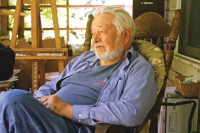Hashing out habitat: Crowd debates wildlife habitat in forest management plan meeting
 More than 100 people filled the room at Asheville’s Crowne Plaza Hotel earlier this month, but they weren’t there for the pretzels. This 16th meeting in the forest management plan revision process for the Pisgah and Nantahala national forests drew people from across Western North Carolina representing a spectrum of interests. Those interests all converged on one topic — wildlife.
More than 100 people filled the room at Asheville’s Crowne Plaza Hotel earlier this month, but they weren’t there for the pretzels. This 16th meeting in the forest management plan revision process for the Pisgah and Nantahala national forests drew people from across Western North Carolina representing a spectrum of interests. Those interests all converged on one topic — wildlife.
“The overall theme that I feel like from the wildlife habitat perspective is to manage this forest for diversity,” Sheryl Bryan, a U.S. Forest Service wildlife biologist, told the crowd.
More than 300 of the 1,000-plus comments the Forest Service has received so far about its management plan pertained to wildlife, and of those, Bryan said, “we did by far receive the most comments concerning the amount of early successional habitat and the mix of age classes associated with that. So the elephant’s out there and we’re going to talk about that.”
The need for young forest
Early successional habitat is the technical name for young forest, an area that has recently been cleared of older growth to allow species that need lighter, more open spaces, to grow. Depending on who you ask, “recently” means sometime within the last 10 to 20 years.
For many wildlife species, young forest habitat is essential. The light-filled meadows allow for a diversity of leafy plants that can’t survive under heavy tree cover, and those plants attract insects, songbirds and other animals to eat them or feed on those that do.
Related Items
They’re also critical for game species such as deer and turkey. That fact has driven interest in the forest management plan up high in the sportsman community, which as a group favors a plan that would increase early successional habitat by a good bit.
“These species require young forest,” said Kyle Brown, vice president of the Southern Appalachian branch of the Quality Deer Management Association. “They’ve been in decline over the past 20 years because older forests are succeeding.”
Succeeding, here, in the technical sense, meaning that older forests are getting older and younger forests aren’t being created.
“If you look at what we have right now, it’s mostly forests that are 50-plus years old, even 70 years old,” Brown said. “It’s a forest that is really the result of logging that happened 70, 100 years ago.”
As the logging industry flagged, clearings in the woods became more rare. During the same timeframe, the Smoky the Bear message of fire suppression reigned, meaning that fire wasn’t widely used as a tool for forest management, either. As a result, Appalachian forests from north to south have become more and more heavily covered with trees that are becoming increasingly older. That means less space for the species that need those younger habitats.
Pinning down the numbers
Depending on your definition of “young,” the acreage of young forest in the Pisgah-Nantahala now hovers around 1 percent, and most stakeholders agree that’s too low. The Forest Service’s preliminary research is exploring what it would take to get early successional habitat to command somewhere between 5 and 20 percent of the forest. But that’s a big range.
“What would be the natural range of variation in a healthy southern Appalachian forest and how far have these forests departed from what they should be?” asked Brent Martin, The Wilderness Society’s Southern Appalachian Region director, in an interview. “The question is where and how much. I don’t think anyone really knows the answer to that question, so we have a lot of work to do.”
Martin agrees that the Pisgah and Nantahala need more open spaces, but he wants to see scientifically-based numbers on how much is necessary before there’s any change in how the forests are managed. He’s also not completely buying the argument that decreased logging and fire suppression are the reason for the decline of game animals such as the ruffed grouse.
“This is the extreme southern end of their range. They’re doing fine in the northern range. Is climate change a factor?” Martin asked about the ruffed grouse’s situation. “I think there are a lot of great mysteries out there that we can’t quite solve yet.”
Jim Gray, of the Ruffed Grouse Society chapter based in Franklin, however, sees a direct correlation between game populations and timber cuts.
“The prior plan had about 20 percent of the forest designated to be cut on a 20-year cycle; in fact, they cut less than 2 percent,” Gray told Macon County commissioners at their July 9 meeting. “Those of us that are grouse hunters, those of us that deer hunt have really seen a difference in terms of the wildlife population.”
The roads question
Which leads to another question. If more early successional habitat is needed, how to go about getting it? Though prescribed burns are great for clearing out understory, timber cuts are generally considered a more effective way to create young forest. And as Gray said, the Forest Service has cut substantially less timber over the course of the plan currently in place, which dates back to 1987, than that plan called for. That’s not due to a lack of takers, said Ruth Burner, leader of the forest plan revision team.
“We generally have not been able to regenerate as much as we anticipated we would be,” Burner said. “We’ve had some reduction in our staffing for one thing. The administrative side of it’s a big one.”
With the federal budget sequester still in place, the Forest Service’s budget crunch isn’t likely to turn into a surplus any time soon.
“The reality is that the Forest Service cannot afford to cut all the trees across the forest that some folks want cut,” said D.J. Gerken, managing attorney at the Southern Environmental Law Center. “We’re going to have to make choices about focusing that action on places where it is most appropriate.”
The appropriateness of a management action can vary a lot depending on elevation, plant community and location relative to existing roads. According to Gray, there are plenty of places in the national forest where logging could be done to the benefit of both economics and environment without really impacting human enjoyment of the land.
“I know people are concerned about scenery and the views, but so many of them are so far back that people who are viewing the leaf change, they aren’t seeing these areas,” Gray said.
In many ways, though, that isolation is exactly the problem, Gerken argues.
“The Forest Service often loses money on its timber sales when you factor in the long-term cost of maintaining roads,” he said. “Which is one reason why for the health of the forest, for the sake of the taxpayer, we are strongly urging everyone to focus our attention on maintaining the existing road network.”
There’s ample data to show that wildlife avoid major road corridors, such as U.S. 74 between Clyde and Bryson City. Roads divide continuous habitat into smaller fragments, create stress inducing noise and can cause death to animals whose crossings don’t jive well with car’s travels.
“You’ve only got like 20 percent of this forest in some kind of condition that’s really unroaded and unfragmented,” Martin said.
But Gray pointed out that there’s a big difference between a four-lane highway and a rugged logging road.
“I don’t agree with the proposition that the roads are bad for wildlife,” he said, because often once the roads are no longer needed, they’re closed to motorized transportation. “They are used for a lot of different uses.”
The roads have to be maintained to some extent to keep dirt from washing off to fill mountain streams, so the corridor through the woods continues to exist. Just not, Gray says, as some high-traffic roadway.
Keeping out invaders
But the road-building question isn’t the only one to consider when deciding how to create that young forest environment.
“I’m concerned about how you’re going to get in there and do your work without opening a path for microstegium, for instance,” said Charlotte Lackey, an invasive weed volunteer. “The money spent on controlling invasives is far more than taking steps now planning on how you’re going to avoid spreading these trees.”
Strategies for pre-empting invasives were a big part of the afternoon discussion. While some groups argue that the forest is a natural system capable of rebounding on its own, others point out that the system — even in the deepest parts of the forest — is no longer entirely natural.
Pests such as hemlock wooly adelgid have already worked themselves into even the most remote areas, and others such as emerald ash borer are on the way. Invasive plants, from Japanese honeysuckle to autumn olive, are quick to get a foothold in disturbed sites, so there’s no guarantee that an area cleared of trees would grow back as a healthy grove of early successional cherry and black locust.
Which brings up another sticking point. Logged areas far from existing roads require new roads if they are to be harvested. But logged areas close to existing roads are prime candidates for colonization by invasives.
“You have to focus three to five years on getting rid of them, especially the first two, with a major expenditure of efforts and labor. Only that way can you really have an effect,” said Bob Gale, an ecologist for the Western North Carolina Alliance. “Whenever we do any of these activities, and even areas where a natural opening occurs, we need to figure out a way to steer a lot more funding to that, and our normal method of funding is not anywhere near sufficient.”
But in all this discussion of the need for young forests, said Hugh Irwin, ecologist for The Wilderness Society, it’s important not to lose sight of the fact that old forests are needed too. And while young forest can be created at any time with a timber harvest, it’s not that easy to make an old growth forest.
“In choosing those early succession candidates, careful thought would have to be put into what areas are put into early successional habitat because that would preclude old growth in that area for centuries,” Irwin said.
He urged the Forest Service to set aside healthy stands of older forest — stands with older trees but also layers of younger trees and understory plants — and keep them safe from harvest. Though a 40-year rotation might be fine in terms of biomass production, a 40-year lifespan isn’t enough for a tree to reach its full potential in terms of either scenery or ecology.
One size doesn’t fit all
Which leads to another consideration in writing the new forest plan. Bryan had kicked off the day with a map-heavy presentation showing all the different kinds of forest communities and ecosystems present in the forest. For the new plan to be successful, she said, it will have to manage each of those ecosystems to reflect their unique characteristics and capabilities.
“One size doesn’t fit all,” Bryan told the crowd. “We’re not going to lay a 10 percent early habitat parameter on the landscape if it doesn’t fit the landscape.”
To demonstrate what she meant, Bryan showed a chart that calculated how many acres of early successional habitat each kind of forest habitat already contained and how many more would have to be added in order to achieve a range of goals for the percentage of early successional habitat the forest should contain.
The numbers are preliminary — they don’t take into account all the trees felled by the hemlock wooly adelgid, for instance — but they give a starting point for forest managers and stakeholders to think about how different milestones of young forest composition could be achieved.
Next steps
Forest managers got some more help in thinking about what the final pen-to-paper management plan might look like from a set of maps that meeting attendees put their own marks on. Armed with arrow-shaped sticky notes, attendees marked the places where large numbers of breeding birds nest, where salamanders are abundant or where game animals are most dense.
“We want to get beyond just the comments we’ve heard before of more this, more that,” Burner told the group. “We want you to get to where on the ground you think are the most important places for those things.”
For the next few months, the revision team will be busy compiling all the comments, all the meeting minutes, all the sticky-note arrows, into the backbone for a revised forest management plan. With that “pre-draft” in hand, they’ll hold public meetings across the region this fall to get public input on the direction they’re headed. Once that’s done, a draft plan will be the next step, one more move along the years-long road to a completed plan, estimated to end in March 2016.
“Now is the time when the revision team is going to start drawing lines on maps,” Burner said.
Fired up about fracking
Not everyone who showed up to the U.S. Forest Service meeting was there to talk about wildlife. A group of about a dozen people had come hoping to talk about oil and gas leasing rules, an item not on the meeting’s agenda.
“We are not making decisions on leasing in the revised forest plan,” forest supervisor Kristin Bail said as she opened the meeting. “We can figure out a way for you to get your input in on that.”
The group had come to the meeting after Lou Zeller, executive director of the Blue Ridge Environmental Defense League, had written a column in the Transylvania Times pointing out that potential for oil and gas extraction was part of the Forest Service’s Need for Change document. The seven-page document lists 43 points that a new forest management plan would address.
Zeller recommended that people who are concerned about hydraulic fracturing, known as fracking, attend the July 10 meeting. Fracking, the process of injecting explosives into a wellbore and pumping in chemicals to hold the cracks open, thus releasing fossil fuels, has revolutionized the energy industry over the past couple decades when fused with horizontal drilling, a technology that allows wells to be deeper with more miles of “pay zone.”
Oil and gas potential are listed in the March 4 version of the need for change document, but Zeller said the first he saw of it was the June 16 version. Thus why he felt the July 10 meeting, the first since the North Carolina General Assembly passed a bill allowing fracking in the state, should have addressed the issue.
“This is a high priority,” Zeller said. “It’s a high priority in Raleigh and it’s not going to go away.”
So, during the first question-and-answer session of the meeting, Zeller stood up to announce that he would lead a separate meeting during the lunch break to talk about fracking. About a dozen people attended, staying for the entire one-and-a-half-hour lunchtime and eventually attracting Bail over to answer a few questions.
Bail stressed that there is not yet any interest in drilling exploratory wells in Western North Carolina — a 2008 Bureau of Land Management study predicted no oil or gas development for the area, and a state study will take another look at the potential later this summer — and explained that the Forest Service would have to work with the BLM to develop mineral leasing rules should any interest in drilling arise. The BLM manages mineral leasing for the majority of the Nantahala and Pisgah national forests.
“That would be a separate decision-making process, a separate public input,” Bail told the group.
That answer didn’t satisfy Zeller.
“We understand the separation of the decision-making processes, but the fact that it is written into the need [for change] is exactly what we want to talk about,” he said.
The new plan will likely deal with the mineral extraction question in some capacity. Though the exact leasing rules would go through a separate process, the new plan would likely include “some general direction on what to do if we should be presented with a request,” said Ruth Burner, leader of the forest management plan revision team. The Notice of Intent to Revise adds that the plan could include standards that “would serve as mitigations should an availability decision be made in the future.”
The revision team’s ideas about what that language should look like would likely be presented in the next round of meetings, which will be scheduled sometime in the fall. That’s when the Forest Service will present a “pre-draft” of the plan, a rough sketch of how the Forest Service has interpreted its scientific data and the public’s desires. No decision has yet been made on whether to hold a separate public input session about fracking.
Though Bail said she expects that energy companies would favor private land over public land should there end up being potential in WNC — development on federal lands must undergo a long, involved environmental impact assessment process — she emphasized that any meeting to talk about leasing rules would not be a forum for people to simply say that they don’t want fracking to happen.
“This isn’t going to be a meeting for folks to say they don’t like it,” she said. “It would be a structured dialogue. It would not be a public hearing.”









